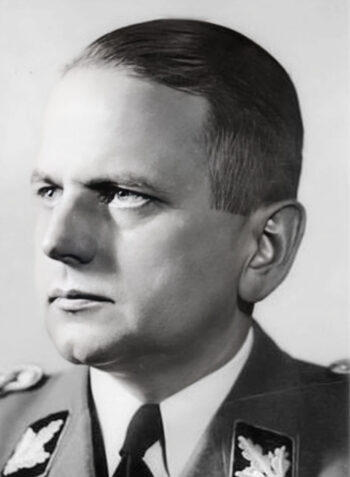Ohlendorf, Otto

Otto Ohlendorf (4 Feb. 1907 – 7 June 1951), SS Gruppenführer, was head of Office III (SD-Inland, Internal Security Service) of the Reich Security Main Office (Reichssicherheitshauptamt). Just prior to the war against the Soviet Union, he was appointed head of Einsatzgruppe D, a position he held for a year. This group operated in the southern region of the temporarily German-occupied Soviet Union (Bessarabia, southern Ukraine, Crimea, Caucasus).
Ohlendorf’s various postwar affidavits and testimonies during the Nuremberg International Military Tribunal and the “Einsatzgruppen Case” of the U.S. Nuremberg Military Tribunals are the mainstay upon which the orthodox dogma is based – that the Einsatzgruppen received a Hitler Order for the wholesale slaughter of Jews on the territory of the Soviet Union prior to the war against that country. However, during his extended investigations of this complex of alleged war crimes, German prosecutor Alfred Streim found out that Ohlendorf had convinced most of his fellow defendants to assume a line of defense that seemed most promising in skirting personal responsibility for the mass executions they were accused of: blame it all on a non-existing “Führer Order.” This didn’t work out as planned, though, as he and 13 of his 21 co-defendants were sentenced to death anyway. As a result, however, the historical record is contaminated with trial statements which are inconsistent with one another, and are not backed up by historical facts (see Jäckel/Rohwer, pp. 107-119; Earl 2009, pp. 182f.; Mattogno 2022c, pp. 132-137).
After the war, Ohlendorf surrendered to British forces in northern Germany. He was brought to London, where he was repeatedly interrogated in the infamous London Cage torture center. After seven weeks of unknown treatment, he admitted responsibility for the mass execution of 80,000 Jews in Russia. On 18 October 1945, he was transferred into U.S. custody at Landsberg prison, where he remained until his execution on 7 June 1951.
At the Nuremberg Einsatzgruppen Trial, Ohlendorf accepted responsibility for at least 90,000 victims of mass shootings carried out by Einsatzgruppe D, while he was in charge of that unit. While there is plenty of documental evidence to support this, this documentation is highly problematic, as a detailed analysis has shown. (See the entry on the Einsatzgruppen as well as Mattogno 2022c in general).
Ohlendorf’s statements about the alleged use of homicidal gas vans are even more problematic. He claimed, for instance, that Himmler presumably issued an order that only men should be executed by shooting, whereas women and children should only be murdered in gas vans, to spare them the horror of being shot in masses. However, this claim is neither backed up by any document nor by any other witness. Quite to the contrary, all witnesses to the alleged use of gas vans claim that men, women and children were killed in them indiscriminately.
When asked about any specific details of the gas vans, Ohlendorf couldn’t answer, as he didn’t know a thing about them: not how the gas was turned on, not whether they had windows. He answered this question with, “That is possible” – which is absurd, because windows in gas vans would have been shattered by the victims.
He knew, however, that a physician once accompanied him in such a van to verify and then write a report that the victims were killed without them ever becoming aware of what was happening. Imagine hot, smoking, stinking, choking exhaust gases spewing into the enclosed space you are in, and you don’t notice what happens, and agree to fall asleep peacefully. This is not realistic. Ohlendorf made up that physician and his report, and it goes without saying that there is no trace of either. Had Ohlendorf really accompanied the physician on that trip, he would have known how that van worked and how it looked. Ohlendorf’s claim that only 15 or 25-30 people fit into that vehicle is at the extreme lower end of all witness claims. He moreover asserted that he refused to enforce Himmler’s order by allowing his men not to use the vans. He insisted that they were used only a few times, leading only to a few hundred gas-van victims. This is rather incomprehensible, considering the efforts presumably made to design, improve and construct the vehicles.
In contrast to this, the Just Document specifically states that 97,000 people had been successfully processed in those vans by June 1942. (See the entry on the Gaubschat Company.) So, who used them? Unless, of course, that document is as false as Ohlendorf’s statements – which it is.
Ohlendorf’s only source of information in this matter were the few documents he was shown by his prosecutors after the war, particular the Becker Document, which he was asked to authenticate twice. He falsely claimed that Becker was the constructor of the gas vans. However, Becker was merely a technician who is said to have made some repairs on them, and to have suggested improvements. Ohlendorf moreover asserted that Becker had always been in charge of the gas vans, meaning that they were never Ohlendorf’s responsibility. However, if these vehicles existed, then the Einsatzgruppen were in charge of them, and so was Ohlendorf as head of Einsatzgruppe D. This was another one of Ohlendorf’s failed defense strategies to confirm the legally unchallengeable claims in an attempt to assuage the court, but to deny any cooperation and responsibility.
(For Ohlendorf’s various postwar statements in these matters see IMT, Vol. 4, pp. 322-324, 332-334; Document 2620-PS, IMT, Vol. 31, pp. 39-41 (German), NMT, Vol. 4, pp. 205-207 (English), and his statements ibid., pp. 301f.)

You need to be a registered user, logged into your account, and your comment must comply with our Acceptable Use Policy, for your comment to get published. (Click here to log in or register.)